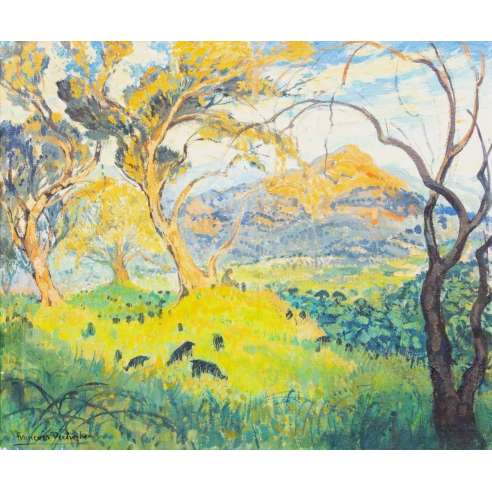This painting by François Théodore Isidore Verheyden displays a vibrant and dynamic landscape, likely influenced by the Post-Impressionist movement. The foreground is dominated by trees with twisting, expressive trunks and branches, creating a dynamic interplay of lines. The use of vivid yellows, greens, and blues creates a luminous effect, suggesting a bright, sunlit day. There is the interplay of light and shadow, characteristic of the Impressionist and Post-Impressionist styles. In the background, a mountain rises, depicting Mont Sainte-Victoire, with its distinctive shape, such as its prominent peak, and surrounding Provençal landscape, which is famous in the art world due to Cézanne's numerous paintings of it.
• Verheyden’s paintings exhibit the vibrant color palette and dynamic brushwork characteristic of the Impressionist and Post-Impressionist movements. His approach to depicting light and shadow, as well as his choice of subject matter, align closely with these styles.
• Verheyden uses bright, harmonious colors to create a lively and engaging scene. The greens, yellows, and blues are particularly prominent, giving the landscape a sense of depth and vibrancy.
• The interplay of light and shadow is masterfully rendered using contrasting shades. This technique not only adds depth to the painting but also enhances the naturalistic feel of the landscape.
• The depiction of natural light filtering through the trees creates a warm and inviting atmosphere. The light seems to dance across the landscape, highlighting different elements and adding a sense of movement.
• The use of light and shadow helps to create a sense of depth and perspective, drawing the viewer’s eye through the composition from the foreground to the distant Mont Saint-Victoire.
Biographical Context
Born in 1880 in Hoeylaert, Belgium, François Théodore Isidore Verheyden was the son of renowned landscape painter Isidore Verheyden and Julienne Rosalie Gérome. Growing up in an artistic household, he was exposed to art from a young age.
Verheyden received his initial artistic training from his father, which laid a strong foundation for his later work. He further honed his skills at the prestigious Academy of Brussels.
François Théodore Isidore Verheyden married Pauline Vanden Eeckhoudt on May 9, 1903. The marriage was childless and eventually ended in divorce. He later married Jeanne Renée Sylvie Gilbert. During World War I, Verheyden relocated to the United States, initially settling in Boston, then moving to Springfield, Massachusetts, and finally Kent, Ohio. It was during this period that his two children were born, one in Boston and the other in Springfield.
Despite his evident talent, the relatively small number of known paintings suggests that Verheyden may not have pursued painting as a full-time career. It is possible that he engaged in other professions or activities, particularly after moving to the USA. According to his family tree, Verheyden was not only a painter but also an industrialist, indicating that he may have balanced his artistic pursuits with other professional responsibilities.
















